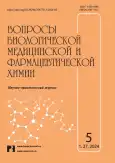Влияние условий культивирования на рост и накопление биологически активных веществ иссопа лекарственного (Hyssopus officinalis L.) в условиях in vitro
- Авторы: Чередниченко М.Ю.1, Хлебникова Д.А.2, Федотова П.А.2, Брем Е.С.3, Романенко В.А.3
-
Учреждения:
- Российский государственный аграрный университет – МСХА имени К.А. Тимирязева»
- Российский государственный аграрный университет – МСХА имени К.А. Тимирязева
- ООО «Натура Сиберика»
- Выпуск: Том 27, № 5 (2024)
- Страницы: 50-58
- Раздел: Фармацевтическая химия
- URL: https://journal-vniispk.ru/1560-9596/article/view/315987
- DOI: https://doi.org/10.29296/25877313-2024-05-06
- ID: 315987
Цитировать
Аннотация
Введение. С древнейших времен эфиромасличные растения широко применялись для лечения заболеваний различной природы благодаря содержанию в них ценных метаболитов и эфирного масла (ЭМ). Иссоп лекарственный (Hyssopus officinalis L.) – распространенная эфиромасличная культура из семейства яснотковые (Lamiaceae Martinov). Надземные части и ЭМ растения обладают широким спектром биологической активности – противовоспалительной, антиоксидантной, антимикробной и др., что определяет использование растительной биомассы и экстрактов в пищевой, лёгкой промышленности, медицине, фармакологии. С появлением технологии клонального микроразмножения стало актуально изучение накопления биологически активных веществ в асептической культуре in vitro (микроклонах и клеточных культурах) при различных протоколах размножения.
Цель работы – изучение влияния условий культивирования иссопа лекарственного (Hyssopus officinalis L.) in vitro на рост микроклонов и накопление в них биологически активных веществ.
Материал и методы. Исследовано влияние минерального и гормонального состава питательных сред на рост асептических растений двух отечественных сортов иссопа лекарственного – Лекарь и Иней (производитель семян – ООО «Гавриш»). Проведено сравнение накопления общей суммы флавоноидов в асептической культуре в зависимости от режима культивирования: степени аэрации культурального сосуда и добавления в среду цитокининового или ауксинового компонентов.
Результаты. Показано, что экспозиция стерилизации (5, 10 и 15 мин) не повлияла на всхожесть семян H. officinalis сортов Лекарь и Иней. Микроклоны H. officinalis, выращенные под ватно-марлевой пробкой, накапливали достоверно больше флавоноидов в листьях, чем растения, выращенные под пищевой пленкой. Добавление в состав питательной среды веществ ауксиновой и цитокининовой природы не приводило к изменению накопления флавоноидов в микроклонах. Установлено, что листья асептических растений иссопа лекарственного накапливают больше флавоноидов (до 3,6 мг/г сырой массы), чем стебли (0,3–1,1 мг/г сырой массы для большинства экспериментальных вариантов), кроме того, сорт Лекарь значительно более богат флавоноидами (2,7–3,6 мг/г сырой массы в листьях) по сравнению с сортом Иней (не более 1,5 мг/г сырой массы в листьях).
Выводы. В связи с отсутствием различий по всхожести между вариантами стерилизации с различной экспозицией можно рекомендовать 5-минутную обработку 5%-ным раствором гипохлорита натрия, как наиболее щадящий режим, обеспечивающий высокий выход асептических проростков (95–98%). Для получения большего количества флавоноидов предлагается выращивание асептических растений под ватно-марлевыми пробками, листья в большинстве случаев являются предпочтительным источником флавоноидов по сравнению со стеблями. Кроме того, уровень накопления флавоноидов в листьях сорта Лекарь более чем в 2,5 раза выше, чем у сорта Иней, что обусловливает большую перспективность использования листовых эксплантов асептических растений сорта Лекарь для индукции образования каллусной ткани и получения суспензионных культур как источников ценных метаболитов фенольной природы.
Полный текст
Открыть статью на сайте журналаОб авторах
М. Ю. Чередниченко
Российский государственный аграрный университет – МСХА имени К.А. Тимирязева»
Email: cherednichenko@rgau-msha.ru
к.б.н., доцент, и.о. зав. кафедрой биотехнологии
Россия, МоскваД. А. Хлебникова
Российский государственный аграрный университет – МСХА имени К.А. Тимирязева
Автор, ответственный за переписку.
Email: khlebnikova@rgau-msha.ru
к.б.н., ст. преподаватель, кафедра биотехнологии
Россия, МоскваП. А. Федотова
Российский государственный аграрный университет – МСХА имени К.А. Тимирязева
Email: polifedou@yandex.ru
студентка
Россия, МоскваЕ. С. Брем
ООО «Натура Сиберика»
Email: e.brem@1reshenie.ru
директор департамента исследований и разработок
Россия, МоскваВ. А. Романенко
ООО «Натура Сиберика»
Email: v.romanenko@1reshenie.ru
технолог-разработчик
Россия, МоскваСписок литературы
- Бахтенко Е.Ю., Курапов П.Б. Многообразие вторичных метаболитов высших растений. Вологда: Изд-во Вологод-ский гос. пед. ун-т, 2008. 266 с.
- Тараховский Ю.С., Ким Ю.А., Абдрасилов Б.С. и др. Флавоноиды: биохимия, биофизика, медицина. Пущино: Sуnchrobook, 2013. 310 c.
- Eibl R., Senn Y., Gubser G. et al. Cellular agriculture: opportunities and challenges. Annual Review of Food Science and Technology. 2021; 12(1): 51–73.
- Gubser G., Vollenweider S., Eibl D. et al. Food ingredients and food made with plant cell and tissue cultures: State-of-the art and future trends. Engineering in Life Sciences. 2021; 21: 87–98.
- Гребенникова О.А., Палий А.Е., Хлыпенко Л.А. и др. Био-логически активные вещества Hyssopus officinalis L. Ор-биталь. 2017. №1. С. 1–8.
- Логвиненко Л.А., Хлыпенко Л.А., Марко Н.В. Аромати-ческие растения семейства Lamiaceae для фитотерапии. Фармация и фармакология. 2016; 4: 34–45.
- Пунгин А.В., Попова Е.А., Ларцева Л.О. Повышение синтеза вторичных метаболитов в культуре бородатых корней H. officinalis. Вестник Балтийского федерального университета им. И. Канта. Серия: Естественные и медицинские науки. 2022; 1: 98–107.
- Работягов В.Д. Изучение содержания эфирного масла в различных органах Hyssopus officinalis L. Бюллетень ГНБС. 2017; 125: 46–49.
- Котюк Л.А. Антимикробная активность эфиромасличных растений семейства Lamiaceae Lindl. относительно Escherichia coli. Ukrainian Journal of Ecology. 2016; 1: 20–25.
- Jankovský M., Landa T. Genus Hyssopus L. – recent knowledge: A review. Horticultural Science. 2018; 29: 119–123.
- Mazzanti G., Lu M., Salvatore G. Spasmolytic action of the essential oil from Hyssopus officinalis L. var. decumbens and its major components. Phytotherapy Research. 1998; 12: 2–9.
- Mitic V., Dordevic S. Essential oil composition of Hyssopus officinalis L. cultivated in Serbia. Facta Universit. 2000; 2(2): 105–108.
- Ozer H., Fikrettin S., Kilic H. et al. Essential oil composition of Hyssopus offcinalis L. subsp. angustifolius (Bieb.) Arcangeli from Turkey. Flavour. Fragrance J. 2005; 20: 42–44.
- Shoja H.M., Shishavan H.K. Effects of different hormonal treatments on growth parameters and secondary metabolite production in organ culture of Hyssopus officinalis L. BioTechnologia (Pozn). 2021; 102(1); 33–41.
- Svoboda K.P., Salambosi B., Deans S.G. et al. Agronomical and photochemical investigation of Hyssopus officinalis L. Agric Sci Finl. 1993; 2(4): 29–33.
- Vallejo M.C.G., Herraiz J.G., Pérez-Alonso M. Volatile Oil of Hyssopus officinalis L. from Spain. Journal of Essential Oil Research. 1995; 7: 567–568.
- Проценко М.А., Мазуркова Н.А., Филиппова Е.И. и др. Противогриппозная активность экстрактов растений семейства Lamiaceae. Химия растительного сырья. 2021. № 2. С. 181–190.
- Murashige T., Skoog F. A revised medium for rapid growth and bio-assays with tobacco tissue cultures. Physiol Plant. 1962; 15(3): 473–497.
Дополнительные файлы












